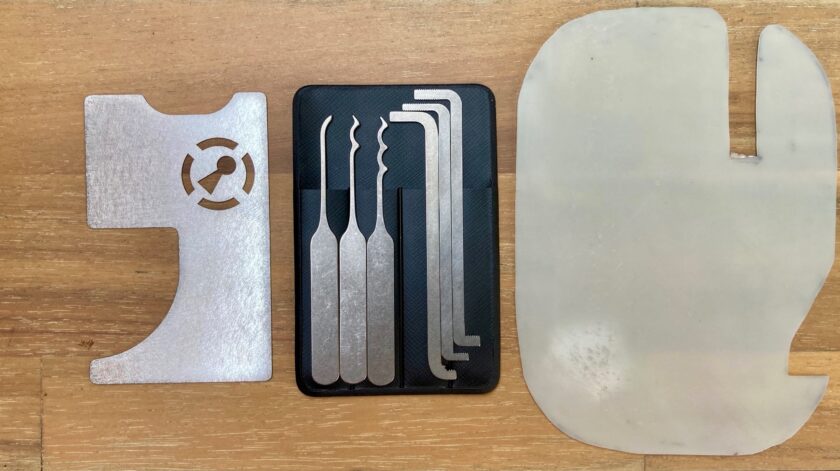I have never carried any real lock defeat gear in my EDC. I just didn’t see the need. In the few short months I’ve worked part-time at EMS I’ve had the need to bypass some locks to get to patients. This has caused me to reconsider my position. Now I carry a minimalist EDC lockpick kit for such emergencies. Today I’ll talk about what’s in that kit, and how it might apply to you.
This article contains a lot of links from Sparrows Lockpicks and SEREPick. I have no financial relationship at all with either company. I purchased all the tools shown here out of pocket (though most of them years ago). Sparrows and SEREPick links exist solely because they provide the best tools for the kit described here.
This article does, however, contain affiliate links to Amazon.com.
Should You EDC Lockpicks?
Everyday carry (EDC) “stuff” can get out of hand. Every expert wants people to carry his or her stuff. Gun-centric people want you to carry a bigger gun and extra mag…and maybe a backup gun. Medical dudes want you to carry a tourniquet. The non-lethal guy wants you to carry pepper spray. Knife folk want you to carry three knives. Preppers want you to carry…well, all sorts of crap. And of course the guys who like lockpicking want you to carry lockpicks on your person at all times.
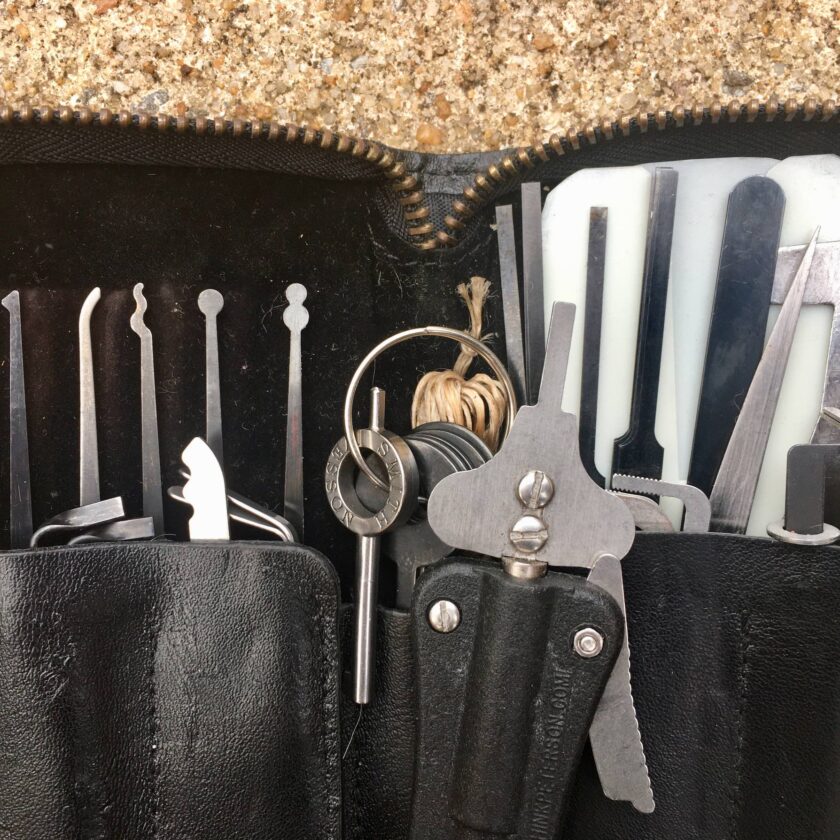
Since this post is about lockpicks let’s ask the question: do you really need to carry lockpicks? I would contend that most of you probably do not. In my lifetime there are only a tiny handful of times that lockpicks would have benefited me. They wouldn’t have saved my life – they would have shortened a minor inconvenience. Honestly, you almost never need lockpicks.
A further consideration is the legality of lockpicks. In some states possession of lockpicks is considered prima facie evidence of criminal intent. If this is the case in my state I’m not sure I’d risk it. This site has a great breakdown of state-by-state legality. There’s also one more consideration that should go into this decision: do you have the skill to use lock defeat gear if you have it?
Skill Over Stuff
All the lockpicks in the world won’t do anything for your if you don’t know how to use them. With the huge emphasis on “stuff” I imagine there are far more people toting around lockpicks than those who have the slightest clue about how to use them. Trust me – skill won’t magically find you in the midst of need. It must be cultivated and maintained.
If you have no skill you can learn a lot from self-study. My favorite book on lock defeat is Practical Lockpicking: A Physical Penetration Tester’s Training Guide, 2nd Edition by Deviant Ollam. I used to give this book to all my students. If you want to learn locks and lockpicking it is well worth the $35 cost. For the nuts-and-bolts of how locks work and how to defeat them, nothing else comes close. A variety of YouTube channels are out there that demonstrate high-quality lock defeat information, like LockPickingLawyer and BosnianBill.
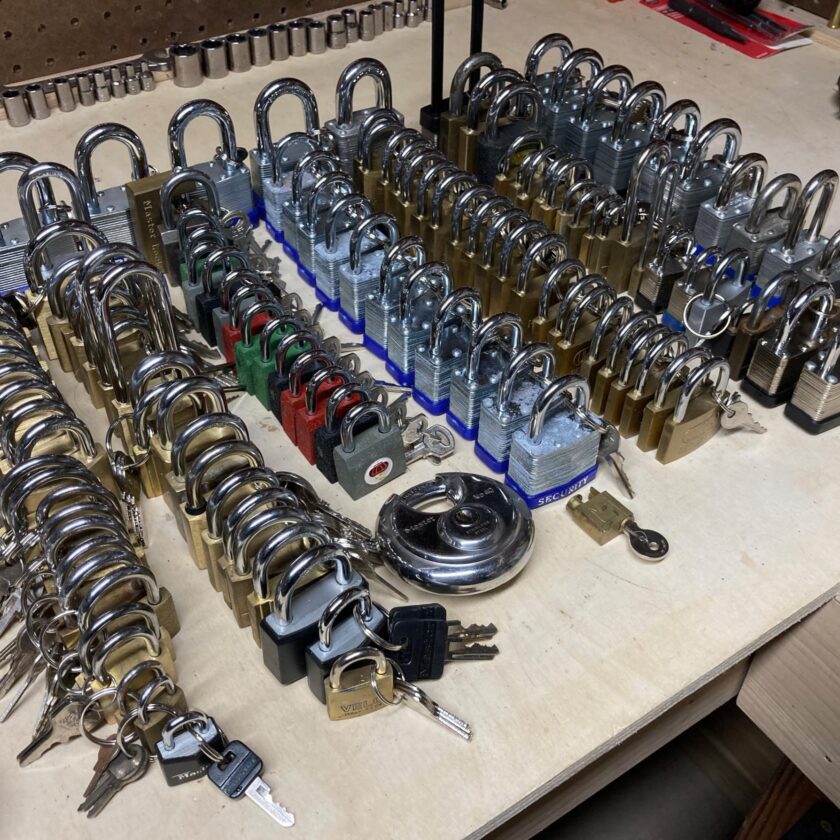
Better yet, get some in-person training. Pat Watson of Uncensored Tactical runs very well reviewed lock defeat courses. I have yet to attend one but based on conversations I’ve had with him I would be comfortable recommending them. Unfortunately I’m not aware of many others teaching open-enrollment lockpicking classes, or at least not ones I’m comfortable recommending. And of course, after you attend training you need to practice. A two- or three- or even ten-day course will only teach you skills that you need to work on. I recommend building out your own lock library and working it.
If you do have some skill, carrying a few minimalist tools might not be a bad idea. If your skill intersects with frequent need to get through locked obstacles, t hen you should probably consider carrying an EDC lockpick kit. The events I’ve recently experienced as a first responder have caused me to reconsider my position on carrying a minimalist EDC lockpick kit. Let’s take a look at it.
The Minimalist EDC Lockpick Kit
Due to the frequency of these events I decided to keep a couple lock tools on me. This wouldn’t constitute an ordinary lockpick kit, just a minimalist EDC lockpick kit. The tools selected had to meet some hard criteria.
- First, these tools had to be extremely compact and lightweight. I already carry enough crap in my pockets. For inclusion an item would have to be very small and light. Ideally it would easily integrate into with my existing EDC and not be an additional, loose item. This probably means carrying some tools in my wallet, which introduces another criteria.
- Second, tools must be durable. Wallet carry has a way of bending and breaking stuff. I don’t want to buy tools, only to have them get bent beyond usability in my wallet. Additionally, wallet carry dictates a very small number of tools.
- Tools need to be high-probability tools. That has a double meaning in this context. The first is that tools must be applicable to the locks I commonly encounter. No one locks their door with a padlock, so I don’t need padlock tools. What I need are simple tools to open common door hardware.
- The other meaning of “high probability” is that these tools must be highly likely to succeed if deployed. There is no room for very specialized bypass tools, comb picks, or other tools that only work under very narrow circumstances. Realizing there is no 100% solution, the tools must work on most things, most of the time.
Unfortunately that means I won’t be able to get through every door. Unlike my Generalist Lockpick Kit, these tools only cover a very few locks. They will, however, allow me to open what I commonly encounter at work: basic locking knobsets and the occasional deadbolt. Let’s get into the contents of the kit.
Carrying the Minimalist EDC Lockpick Kit
Not wanting to add another, separate item to my EDC I decided that my wallet was best-bet for carrying lock tools. I carry a fairly large wallet. I like it because it spreads my cards out and remains very flat, despite having a wide footprint. It is made by Bellroy and is designed to hold a passport, and be waterproof. Man, I’m a sucker for gear marked “waterproof,” and it has been a phenomenal wallet. Unfortunately, it is no longer manufactured. The closest thing to it (I think) is the Bellroy Travel Folio.
That’s probably way more than you want to know about my wallet. I’m explaining it so the layout of my kit makes sense. If you desire to wallet-carry your kit your wallet will play a huge role in determining what you may add to your “kit.” With storage out of the way, let’s look at the contents.
If you don’t have the same wallet I do (which is probably the case) check out THIS ARTICLE. It describes a homemade wallet lockpicking kit. Many of the included tools are the same as what’s in my wallet. In any case, it’s a good article with detailed descriptions and photos.
Tool #1: Shim Material
The first item I chose for my extreme minimalist kit is a piece of shim material. If I only had one item, this would be it. It checks all my boxes. First, it is perfectly sized as I can cut it to fit my wallet. It’s flat and flexible, and takes up nearly no space. Next, it’s the most commonly needed item. It works on inward-opening knobsets with a live, but locked, latch. I have written about this technique before. It doesn’t always work, but it often does.
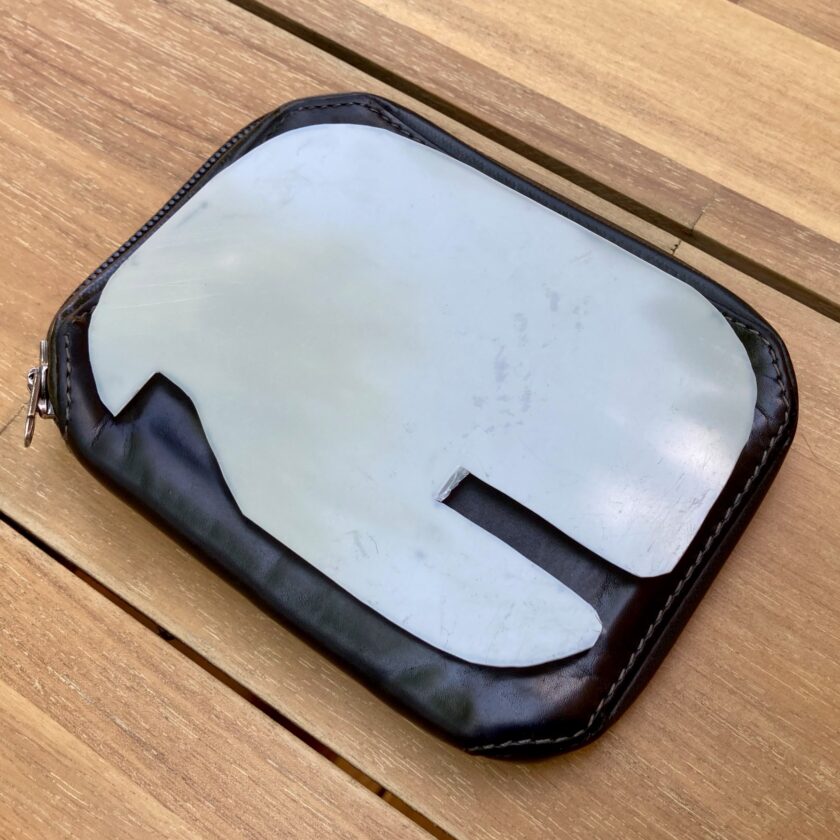
This item is cut from Sparrows’ “Quick Shim” material (the thicker piece). In my previous article I recommended using a Starbucks gift card or hotel key. This works, but not as well as true shim material. Shim material is much more flexible and able to get into tight door jambs. It can also be cut much larger pieces, giving you more flexibility. On the other hand, Starbucks gift cards are very innocent and require no explanation.
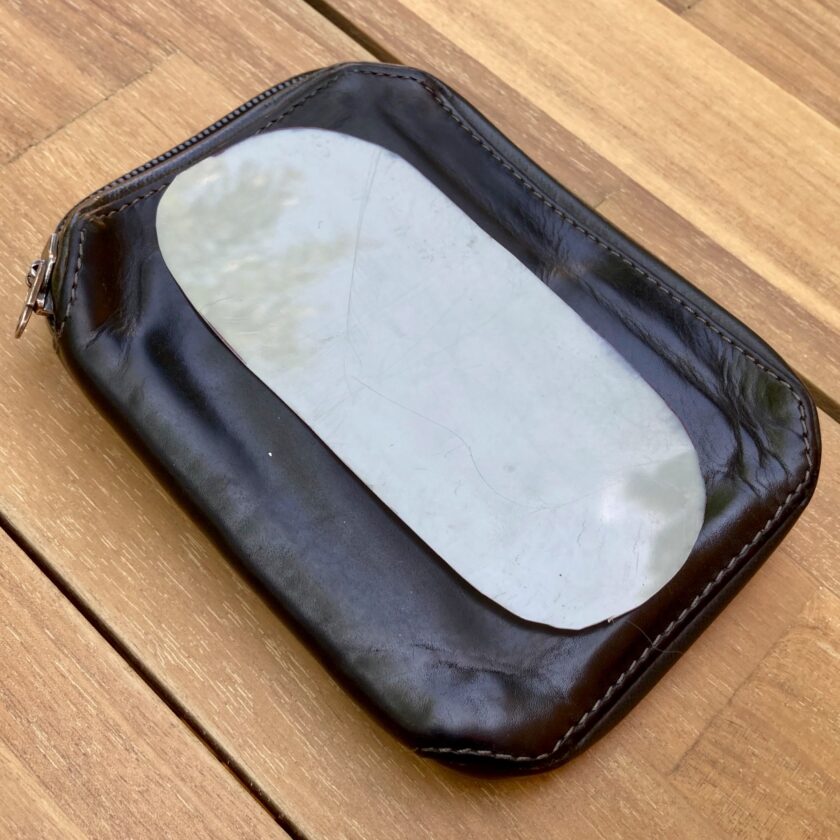
I also cut and briefly considered carrying a piece of the thinner shim material, as well. This one didn’t make the grade, though. It added thickness to my wallet but didn’t add an equivalent capability. It would be useful with extremely tight door jambs, but that’s a compromise I’m willing to make.
Modifications to the Shim Material
You will notice that I made a few modifications to make my shim. First, I cut it down to fit in my wallet. Next, I rounded all the sharp edges. Sharp edges catch in weather stripping, interfering with the tool’s effectiveness. They can also cut it, damaging property. Avoiding property damage is a pretty high priority for first responders. I recommend at least rounding your edges, but leaving the tool as large as possible.
Next, I cut a couple shapes out of this piece of plastic. The hook at top-left works for on latches for outward opening doors with live latches. It’s not as strong as metal (like the Sparrows Hall Pass) but it works more often than not. The long groove on the bottom edge is for those hotel-door privacy locks. You know, the kind with the double bar that pivots over the horn on the door? If you get the rest of the door unlocked, this tool will undo that privacy latch. I’m not likely to need that but it costs me nothing to add it, so why not?
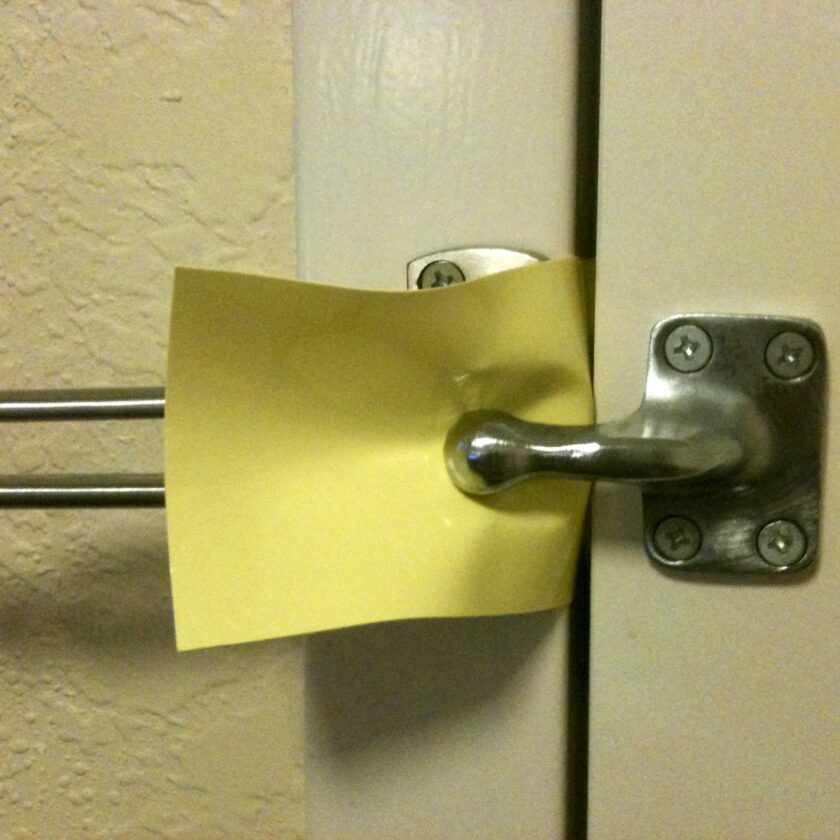
Honestly, I could almost stop here. A good shim will do 90% of what I need it to do. It’s lightweight and compact, durable, and high-probability. Since common door hardware is my main “target” I can go just a bit further and stay well within my size/weight limits. Let’s look at the next tool in my minimalist EDC lockpicking kit.
Item #2: Sparrows Flex Pass
The next tool I added was the Sparrows Hall Pass. This tool also works on locked but live latches, but works on outward-opening doors. I have an improvised, outward-opening tool cut into my shim material, but I opted for this dedicated tool.
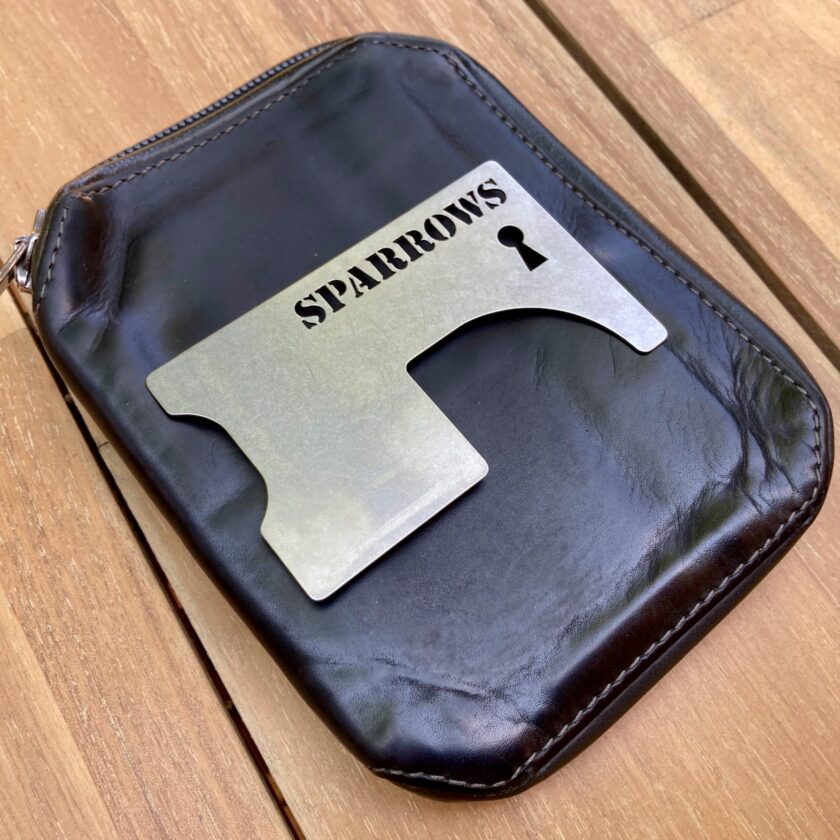
I would have not included this tool, but a couple factors persuaded me. First, it is steel and much stronger than my shim material. Sometimes unlatching outward-opening doors requires a slightly stronger tool than plastic shim. Second, it fits in the exact footprint of a credit card. Third, it is very compact, lightweight, and durable. Finally, this bypass is needed commonly enough that it makes sense.
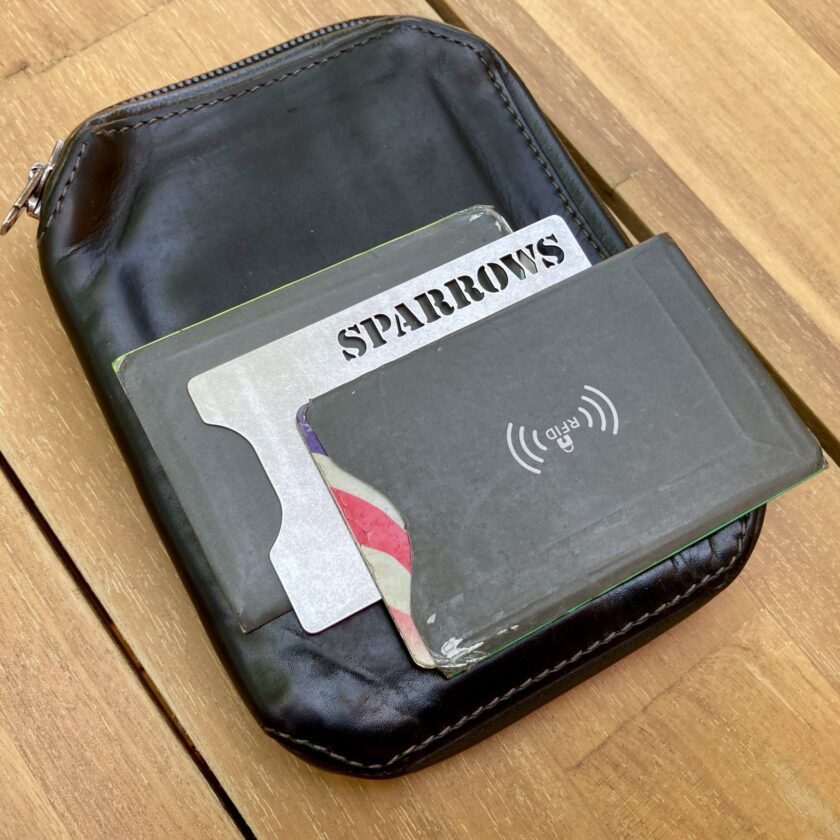
I initially purchased the Sparrows Hall Pass. It is the exact same tool but much thicker and heavier. The Flex Pass, at half the thickness of the Hall Pass, still works most times the Hall Pass does. I just chose the lighter, thinner variant.
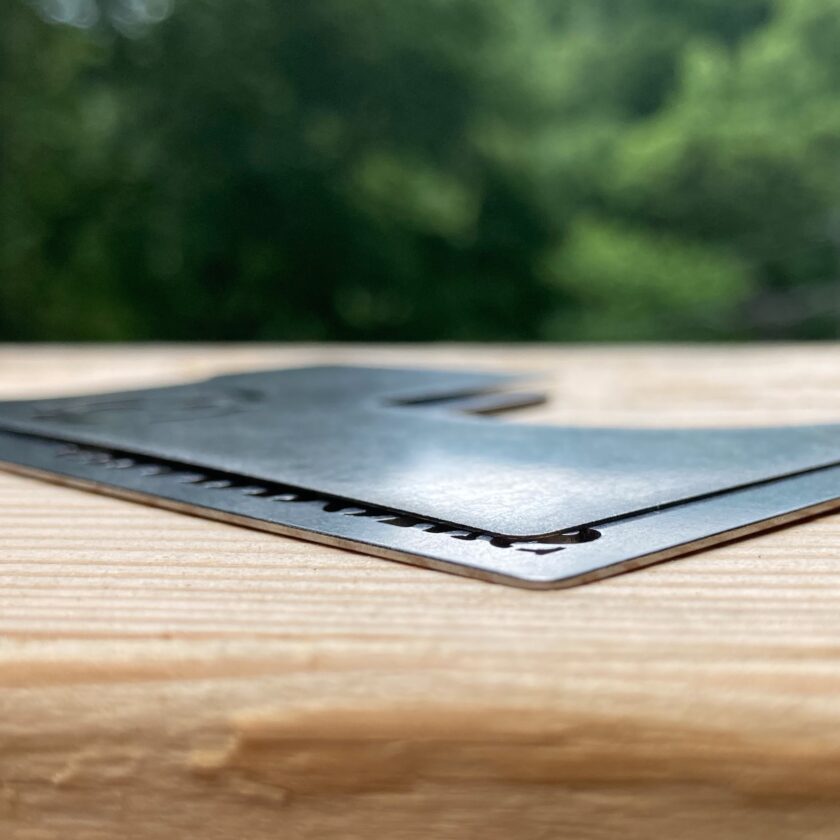
These two tools will do most of what I need to do: quickly open locked, latches on knob- and lever-sets. Once in a while, though, I actually encounter a locked deadbolt. It is embarrassing to admit, but once the fire department had to take a side door off its hinges. This was pretty standard for them, but it made me sad that I couldn’t provide a faster, more elegant solution. So, I decided to add a couple actual picks to my kit.
Item 3: Bogota Rakes
Lockpicks don’t guarantee an entry. They do give you a probability of success roughly equal to your level of skill. If you have no skill (i.e. no training, no dedicate self-study, and no regular practice) you can probably skip the lockpicks. However, if you do have some skill, it wouldn’t be a bad idea to have at least a couple picks. If nothing else they’ll give you something to do while firemen look for a forced-entry option.
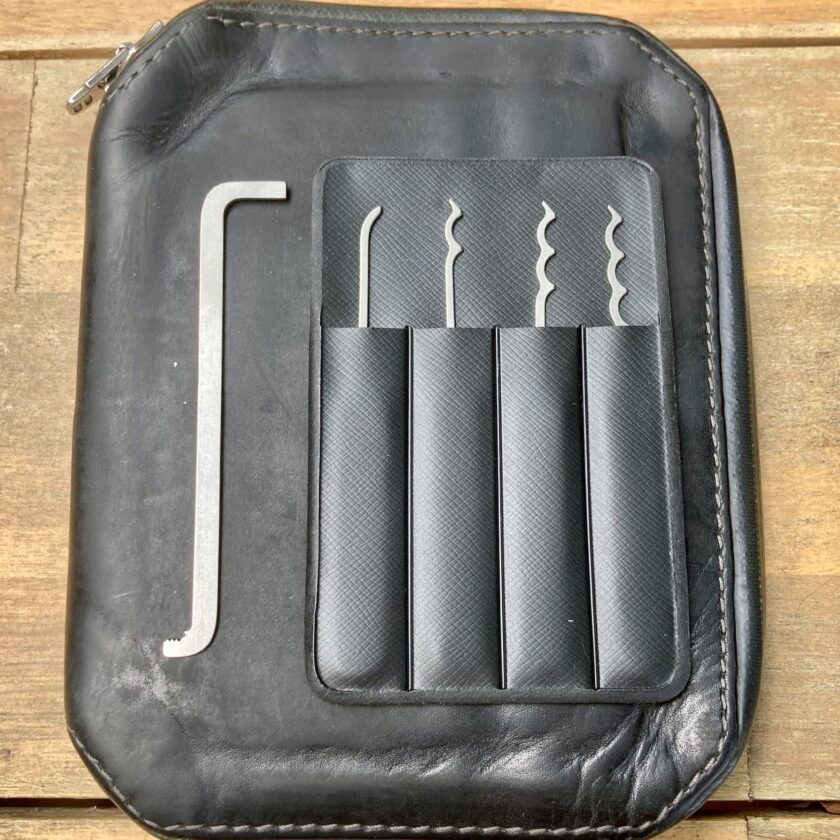
My first pick option is the Bogota Pi Set from SERE Pick. My instinct was to go as small as possible, I’ll talk about those tools shortly but bottom line: I need a pick with a handle on it. Otherwise my success rate isn’t great. So, I went with the Bogata Pi. First, the kit is 3.14 inches long so it fits into a wall. The default kit comes with four picks: a hook, and double-, triple, and quad-hump rakes. It also comes with one flat tension tool.
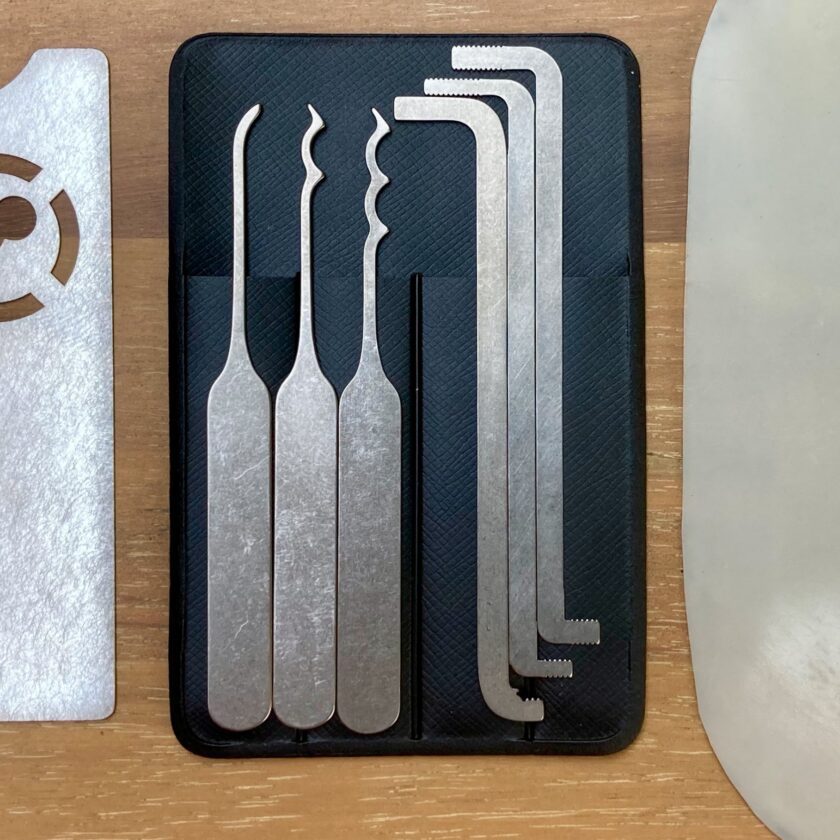
I made some modifications to this setup. First, I got rid of the quad-hump Bogata. It’s difficult to imagine using it all that much…or at all. Next, I added two additional tension tools. Both of these are from Peterson’s Flat Five set. This ended up being a pretty damn good set of lockpicks that fits neatly into a wallet.
Tools That Didn’t Make the Cut
There were a couple tools that I tried that just didn’t quite work out. The first was the Bogata Titan set from SEREpick. Thes picks are incredibly small and concealable. They also fit perfectly in my wallet. My Bellroy wallet has slot for a miniature pen, and they slide nicely into that slot. They are easily retrieved, yet fairly secure. Even if I had to open my wallet in front of a police officer, I seriously doubt these would be noticed.
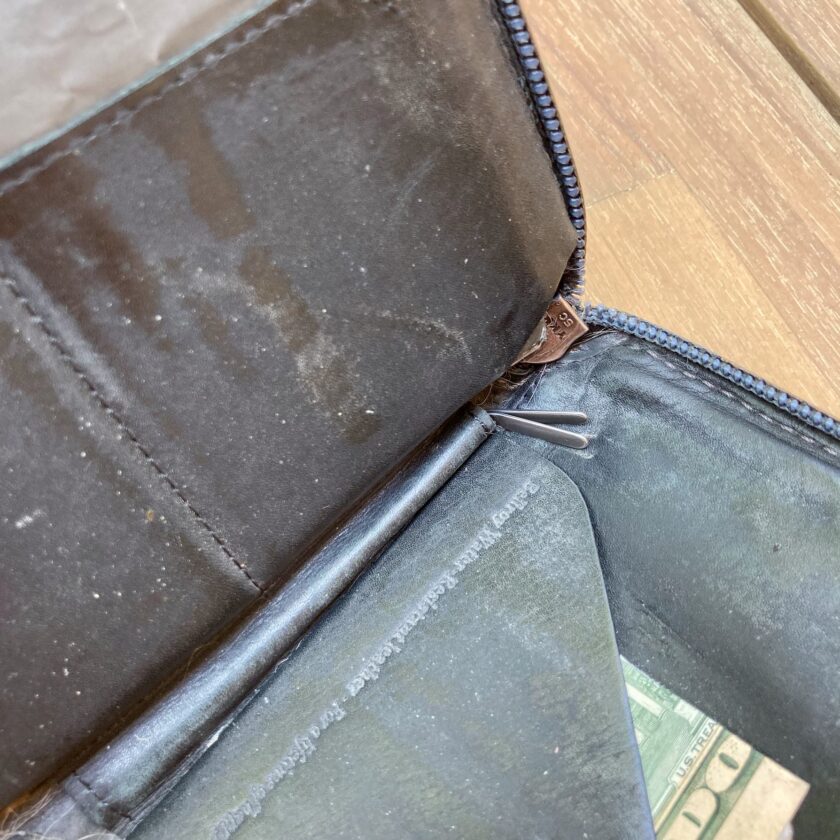 Unfortunately they don’t do much for me. I’m sure I’m the only blogger that is willing to admit it but I just don’t have great success with these picks. Sometimes they work and sometimes not. Even though they’re small it’s not really worth carrying them if they don’t bring a capability to the table.
Unfortunately they don’t do much for me. I’m sure I’m the only blogger that is willing to admit it but I just don’t have great success with these picks. Sometimes they work and sometimes not. Even though they’re small it’s not really worth carrying them if they don’t bring a capability to the table.
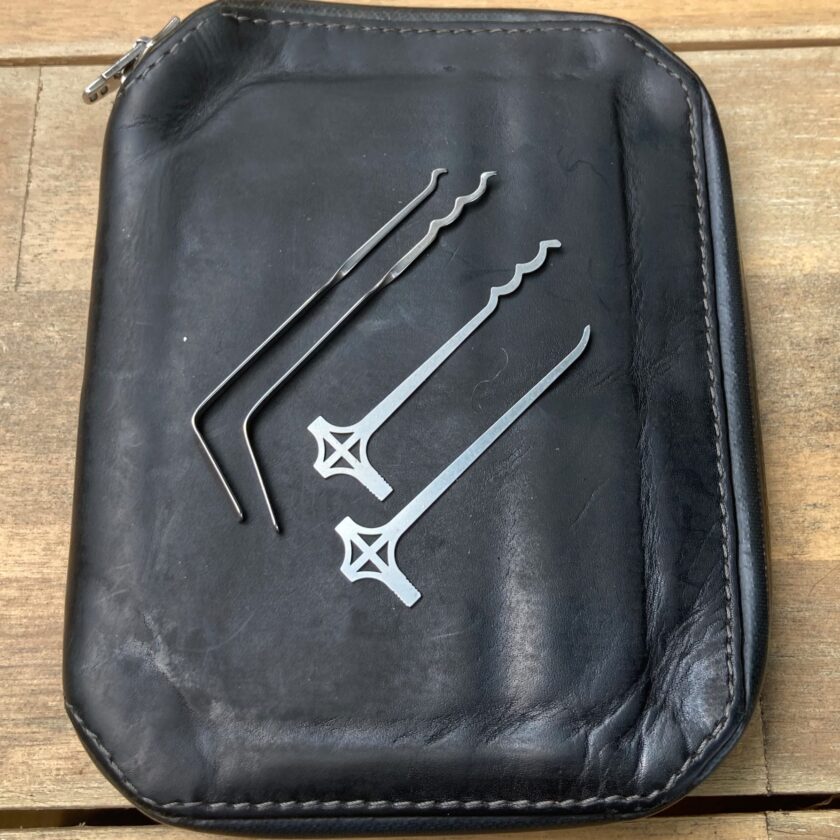
Next up were the Sparrows Mace Picks. The Mace set consists of a triple Bogota and a hook. They sit nice and flat and take up almost no space. Like my Bogota Titan set, each pick doubles as a tension tool. Also like the Bogata Titans these just don’t do much for me. They’re sort of like carrying a NAA mini-revolver: awesome for carry, but they’re probably not going to do much for you if you really need them.
Conclusion
And that’s my minimalist EDC lockpick kit. No specialized tools, no sexy, cool-guy items. Just small, lightweight, durable, high-probability items. And the skill to use them effectively. This is my kit. I definitely don’t recommend you run out and purchase this same stuff – I had most of it lying around. but if you’re thinking about a minimalist EDC lockpick kit maybe you can glean some useful information here.
Carrying gear around without skill won’t make your prepared. Skill is critical to the employment any tool, so I strongly encourage you to develop some skill. Well-developed skill will make each tool in your kit more valuable. The more you know, the less stuff you need, and the more you can do with what you have. If you do have some skill it’s not a bad idea to carry a minimalist lockpick kit. It won’t get you into anything but it’ll get you into most stuff, most of the time.
